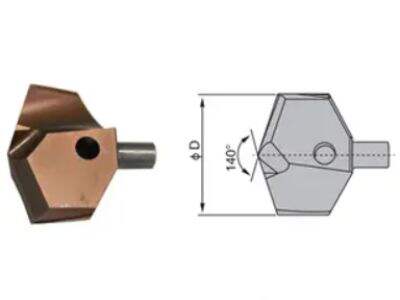Drill inserts are essential tools used in manufacturing and construction industries. It’s the little things, as they say, and those little things can have a big impact on how well a drill actually works. There are 5 things that influence how a drill insert can perform. Let's deep dive into each one of these to understand how they can have a positive impact on our work.
The effect of varied materials on performance of drill inserts:
What materials are used to make drill inserts impacts them in a number of ways. Some are tougher than others, which means they can run longer and cut through tough stuff more readily. This ensures that holes will be as precise and clean possible, helping the bit perform time after time without dulling, saving time and money with replacements. NIGEL NELSON knows using the right materials is important when it comes to making drill inserts that not only work well, but also last a long time.
The efficacy of drill inserts can be dramatically affected by their design and shape:
The shape and configuration of a drill insert can determine how efficiently it cuts. Some work better at clearing chips and debris out of the hole, since they can tend to remove that material more efficiently than they grind on the hole being drilled. Other shapes can also increase stability and accuracy — insuring that the hole winds up in the right spot. NIGEL has also put considerable care into the design of their Drill Inserts, so that they function to the highest standards.
Drill inserts can differ by the type of coating that is coated on their surface, which affects the adhesion, and thus durability, as well as cutting performance:
Drill inserts can also be coated to resist wear and tear, to keep them cutting for longer periods. Some coatings can even help to minimize friction, too, which makes it a lot easier for the drill insert to make its way through these tough materials. The right coating applied to Drill Inserts can help them to operate more effectively and last much longer heading longer time = savings over time. NIGEL puts a mean coating on their drill inserts to insure uses over and over without wearing out.
To optimize drill insert cutting performance adjust feed and speed correctly:
The speed with which a drill insert spins and how quickly it rides through the material to be drilled can play a huge role in how well it does its job. Too slowly, and the drill insert might not last very long. Too quickly, and it may fail to slice through the material. And with the optimal feed and speed, Drill Inserts are able to perform at their fullest potential, consistently slicing through materials with a quick, clean cut. NIGEL understands that obtaining the correct feed and speed is key to ensuring the performance of their drill inserts.
Selecting drill inserts for the workpiece hardness is key for good results:
All drill inserts are not created equal, and as a result, they can’t handle all materials. Some are better for soft materials like wood and others are for cutting through tougher metals. Selecting the right drill insert based on the hardness of the material you are drilling is key to achieving the results you desire. The use of the incorrect drill insert can result in sub-standard performance and potential work piece damage. NIGEL -There is 4 type drill insert for different material, so it is easy to select a correct type for the task.
Table of Contents
- The effect of varied materials on performance of drill inserts:
- The efficacy of drill inserts can be dramatically affected by their design and shape:
- Drill inserts can differ by the type of coating that is coated on their surface, which affects the adhesion, and thus durability, as well as cutting performance:
- To optimize drill insert cutting performance adjust feed and speed correctly:
- Selecting drill inserts for the workpiece hardness is key for good results:

 EN
EN
 AR
AR
 BG
BG
 HR
HR
 CS
CS
 DA
DA
 NL
NL
 FI
FI
 FR
FR
 DE
DE
 EL
EL
 HI
HI
 IT
IT
 JA
JA
 KO
KO
 NO
NO
 PL
PL
 PT
PT
 RO
RO
 RU
RU
 ES
ES
 SV
SV
 TL
TL
 IW
IW
 ID
ID
 LT
LT
 SR
SR
 SK
SK
 UK
UK
 VI
VI
 HU
HU
 TH
TH
 TR
TR
 FA
FA
 MS
MS
 GA
GA
 AZ
AZ
 BN
BN



